 David Roberts, R.A. (1796 - 1864)
David Roberts, R.A. (1796 - 1864)
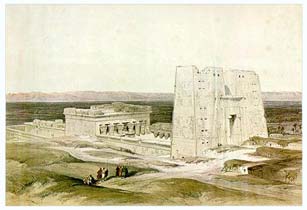
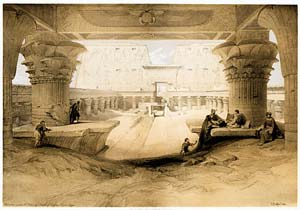
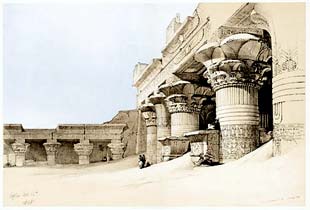
Youth and apprenticeship
David Roberts was born the son of a shoemaker at Stockebridge, near Edinburgh, on 24-October 1796. Encouraged by his family he started very early to describe and depict his surroundings, especially the castles and ruins at the countryside of his hometown. At the age of 11 or 12 he started a seven-year apprenticeship with a local decorator, from whom he learned some of the basic techniques in painting. But he learned mostly by spending all his free time sketching and painting. In general we can say he remained all his life a remarkable gifted self-educated artist. He started work in 1815-16 as an assistant set designer in a small theatre in Edinburgh. A few years later he became the official painter of the Royal Theatre in Glasgow and somewhat later in Edinburgh.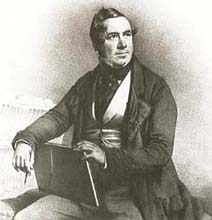 Starting his career
Starting his career
Already by that time he became increasingly famous and in 1821 he received an offer to work for the Drury Lane Theatre in London, and two years later for the Covent Garden opera house. About 1826 he published his ,View of the Cathedral of Rouen', which was shown at the Royal Academy and highly praised by the critics. After that he received more and more response from private clients and in 1830 he decided to give up his work as a set designer to start a career as a studio painter. In 1831, aged 35, he was elected chairman of the Society of British Artists.
Travelling in Europe
From 1831 on he began to travel in Europe. First he visited France, in 1832/33 he spent nearly two years in Spain, at that time a little known country, sketching buildings, monuments and ruins from a wide variety of periods. From all his travels, also in Germany and the Netherlands, he brought back a great number of sketches, which served as a basis for many publications, e.g. 'Pilgrims of the Rhine' or 'Picturesque Sketches of Spain'.
Travels through Egypt
Roberts left London for the Near East in August 1838. At the end of September he arrived in Alexandria. Here he met the consul, Robert Thornburn, well known to British travellers of the period because of his unrivalled helpfulness. On 27-September, Roberts started to Cairo, 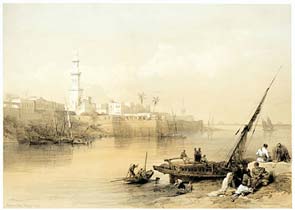 where he arrived on 30-September. He stayed for a week in Cairo, preparing for his travel, and he had only time for one sketch. He hired a boat and finally he embarked on 6-October with a crew of eight men, plus his personal servant, to sail up the Nile as far as Nubia and Abu Simbel.
where he arrived on 30-September. He stayed for a week in Cairo, preparing for his travel, and he had only time for one sketch. He hired a boat and finally he embarked on 6-October with a crew of eight men, plus his personal servant, to sail up the Nile as far as Nubia and Abu Simbel.
Roberts was deeply impressed by the country, especially the riverside temples and all the archaeological sites in the region, although much was still unexcavated and the major temples were still buried.
During the quite arduous voyage up the Nile he only made a dozen sketches. On Friday 9-November-1838 they reached Abu Simbel and Roberts described it as "the monument which alone makes the trip to Nubia worthwhile." The other members of the expedition continued as far as Wadi Halfa to see the Second Cataract, while Roberts decided to work on some drawings.
On 11-November they began to descend the river and Roberts mentioned this in his diary with the words: "Thank God our vessel's prow now faces the north and civilization". On the way back he sketched, depicted and described as much and as closely as possible the country and his people.
Just a few hours after starting their way back, they tied up near the Fortress of Ibrim. The next days they visited the temples of Wadi Maharraka and Wadi Dabod, the Temple of Dakke, the Rock Temple of Gyrshe, and the Temple of Kalabsha. At Wadi Kardassy Roberts depicted a group of Nubians from whom he bought some souvenirs for a quite reasonable price.
From 17 to 19-November they stayed at the Island of Philae. On their way to Karnak and Luxor, Roberts depicted the Temple of Kom Ombo, the Temple of Edfu, and the Temple of Esna.
On 26-November they came in sight of Karnak and landed near the great sanctuary. During the next few days Roberts drew several pictures of the Temple of Karnak. In his diary we find the sentences: "Karnak is even more astonishing than Luxor. Its magnificence is unimaginable. Trying to describe rationally what I have seen would be ridiculous."
Maybe for this reason he only spent one day, 1-December, in Luxor and travelled next the plain of Thebes to depict the Valley of the Kings, the Colossi of Memnon, and the Ramesseum at Thebes. They left ancient Thebes on afternoon 5-December and reached Dendera the next morning and Roberts set to work enthusiastically. By 9-December Roberts had 100 drawings of all the well known temples from Abu Simbel to Dendera and he decided to be satisfied with his work and to go straight back from Dendera to Cairo.
They finally reached Cairo on the morning of 21-Decembe. Roberts rented a house and spent over a month there. Dressed like an Arab he recorded the people, streets, and architecture, drawing more than two dozen pictures of the town. 17-January-1839, he returned to the Giza after his first visit three and a half months before and he made some splendid drawings of the Pyramids and the Sphinx.
Travels through the Holy Land
On 7-February he started the second part of his journey through the Near East. He left Cairo for the Holy Land in company with 15 Arab guards and 21 camels. First they went via Suez to the Mount Sinai. Here they stayed from 18 to 23-February at the Monastery of St. Catherine. Next they travelled along the Gulf of Aqaba to Petra and the Mount Hor. They reached this area on 6-March, and Roberts painted all the historical sites around during the next five days. Petra proved for Roberts a theatrical wonder, and, as he wrote in his diary "probably one of the greatest challenges on earth to a painter."
Leaving this area on 11-March they first passed Wadi Arabah and the Ruins of Semua on their way to Hebron. Before going to Jerusalem they made quite a detour via Beth Gebrin, the ancient Eleutheropolis, Gaza, Askelon, Ashdod, Jaffa, and Lod, in order not to miss any of these important historical points of interest.
On 29-March, a Good Friday, they arrived in Jerusalem. Roberts wrote in his diary: "I made the circuit of the city walls, proceeding northward by the gate of Damascus and the Valley Jehoshaphat to the hill of Sion, where the tomb of David is placed."
During his first days in the town he only drew a few pictures and after three days he decided to make a roundtrip for a week to visit Jericho, the river Jordan, and the Dead Sea. He returned via the Monastery of St. Saba and Bethlehem and to Jerusalem, where he stayed for another week to make more sketches and drawings.
The third part of his journey through the Holy Land led him to the Northern part of the country, from Jerusalem to Baalbec. He started on 15-April to Nablus making some pictures during the next two days. From there Roberts and his travelling companions followed a track to Nazareth, on which they passed the very imposing Mount Tabor.
From Nazareth they went to Cana of Galilee and the Sea of Galilee (Tiberias). "21-April, Sunday: Passing on through a beautiful country. we came in sight of the Sea of Galilee. Far to the left is Mount Hermon, and near to us Safed.". From there they went westward to Haifa and the Mount Carmel and then they followed the coastline to the north via Tyre to Sidon, the ancient and most important Phoenician ports.
During the first days of May they arrived at Baalbec, the ancient Heliopolis. Because of an incipient fever, Roberts had to stay the first day in bed. But nevertheless, even the next day he started work again. During the following week he stayed in Baalbec and drew half a dozen sketches. Among them are his finest pieces of work. He was elected as a member of the Royal Academy (R.A.) as a result of his oil-on-canvas painting "Doorway of the Temple of Bacchus". This painting was an elaboration of the sketch he did in Baalbec, completed later at his home in London.
On 13-May he boarded a ship bound for Alexandria, where he arrived after a voyage of three days. About one week later he embarked for England, where he arrived at the 21-July-1839.
Publication of the lithographs
Back again in London, he submitted the results of his journey, 272 sketches, a panorama of Cairo and three full sketchbooks, to numerous publishers. He received the right kind of interest from Francis Graham Moon, who offered him three thousand pounds to publish the work. The lithographs were produced by Louis Haghe on the basis of Roberts' own drawings and comments. The production of the prints involved over 600 lithographic stones. M. Tayman wrote: "Roberts' Holy Land and Egypt project is the most ambitious work ever published in England with lithographic plates." For the lithographic process various techniques were used by L. Haghe and his assistants to achieve numerous tonal effects. The lithographs were printed with 1, 2 or 3 tints.
The prints were published by F G Moon. London, between 1842 and 1849 and issued in six volumes with all 247 prints. The text for the 'Holy Land' series was written by Rev. George Croly and by William Brockedon for the ,Egypt and Nubia' series. In a Subscription or Deluxe Edition, published at the same time of the First Edition, the prints were presented like watercolours. They were coloured and finished by hand, trimmed to the image and mounted to a backing board without text.
Two years after Roberts came back home to London he became a full member of the Royal Academy (R.A.). Now he started again to visit many countries in Europe and during the next decades he had great success, in Britain and abroad, with his paintings and engravings in leading galleries, for which he received many prizes and awards. His huge clientele, as well as his friends, included many of the leading personalities of this time, such as Charles Dickens, William Turner or William Thackeray.
David Roberts died at the age of 68 on 25-November 1864 and was buried in Norwood cemetery. His private collection of his own sketches, drawings and prints was auctioned one year later by Christie's and spread all over the world. Most of his oil paintings are exhibited in leading English and Scottish museums.
Source:
Kunstantiquariat Monika Schmidt - Based in Munich Germany - Specialist, since 1970,for Rare Old Maps and Views, and for Fine Decorative Prints from the 15th to 19th century.
Contact & Feedback : Egyptology and Archaeology through Images : Page last updated on 05-October-2025